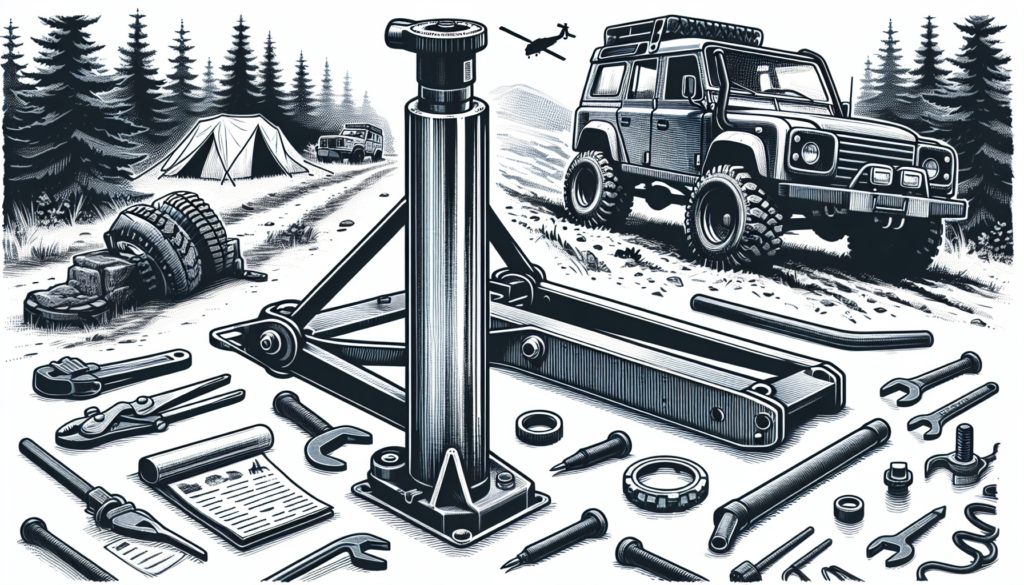Have you ever wondered about the most effective ways to utilize a high-lift jack? Whether it’s for off-roading adventures or simply handling some heavy lifting, a high-lift jack can be a valuable tool. In this article, we will explore some of the best techniques for using a high-lift jack, ensuring that you are equipped with the knowledge to handle any lifting or recovery task with ease and confidence. So, let’s get started and delve into the world of high-lift jacks!
Choosing the Right High-lift Jack
When it comes to choosing the right high-lift jack, there are a few factors to consider. First and foremost, you need to take into account the weight capacity of the jack. Make sure that the jack you choose can handle the weight of your vehicle. It’s always better to go for a jack with a higher weight capacity than what you actually need, as it provides an added safety margin.
Next, you should check the lifting height of the jack. This is important because you want to ensure that the jack can lift your vehicle high enough to perform the tasks you have in mind. Whether you’re changing a tire or using the jack for recovery purposes, having enough lifting height is crucial.
Durability and build quality should also be taken into consideration. Look for a high-lift jack that is made from sturdy materials such as steel. This will ensure that the jack can withstand heavy use and last for a long time. Additionally, pay attention to factors like the finish and the design of the jack, as these can also contribute to its overall durability.
Preparing for Use
Before using a high-lift jack, it’s important to thoroughly inspect the jack for any damage or defects. Check the lifting mechanism, handle, and other components for any signs of wear and tear. If you notice any issues, it’s best to have the jack repaired or replaced before using it.
Proper lubrication is essential for the smooth operation of a high-lift jack. Take the time to ensure that all moving parts are properly lubricated before using the jack. This will help prevent friction and ensure that the jack operates efficiently.
Once you have inspected and lubricated the jack, it’s crucial to test the lifting mechanism before actually using it. Raise and lower the jack a few times to make sure it functions properly. This will give you peace of mind knowing that the jack is in good working condition.

Using a High-lift Jack Safely
Using a high-lift jack requires some safety precautions to ensure that you and your vehicle remain safe throughout the process. First and foremost, always find a stable and level ground to operate the jack. Uneven surfaces can cause the jack to become unstable and increase the risk of accidents.
Before using the jack, securely chock the wheels of your vehicle to prevent any accidental rolling. This is especially important if you are working on an incline or on a surface that is not completely level. Chocking the wheels will help keep your vehicle in place and prevent it from moving unexpectedly.
Wearing appropriate safety gear is essential when using a high-lift jack. Always wear sturdy gloves to protect your hands from any potential injuries. Additionally, consider wearing safety glasses to protect your eyes from flying debris or other hazards.
Lastly, it’s important to carefully read and follow the manufacturer’s instructions when using a high-lift jack. Different jacks may have specific guidelines or safety precautions that you need to be aware of. By following the manufacturer’s instructions, you can ensure that you are using the jack in the correct and safest manner.
Lifting Techniques
To effectively use a high-lift jack, it’s important to understand proper lifting techniques. When positioning the jack on the lifting point of your vehicle, make sure it is centered and securely attached. This will provide stability and prevent any unnecessary movement during the lifting process.
When operating the handle of the jack, remember to use smooth and controlled movements. Avoid applying excessive force or jerky motions, as this can lead to instability or damage. Slowly and steadily raise the jack, keeping a close eye on the stability of the vehicle.
To further enhance stability and protect your vehicle, consider using a block of wood between the lifting point and the jack’s lifting mechanism. This will distribute the weight more evenly and prevent any damage to the vehicle’s undercarriage.

Using a High-lift Jack for Recovery
A high-lift jack can be a valuable tool for vehicle recovery. When using the jack for recovery purposes, it’s crucial to attach it to a secure recovery point on your vehicle. Consult your vehicle’s manual to identify the designated recovery points. Attaching the jack to these points will ensure maximum safety and prevent any damage.
To lift the vehicle during a recovery operation, operate the high-lift jack just as you would for any other lifting task. Slowly raise the jack, keeping a close eye on the stability of the vehicle. Once the desired height is reached, you can proceed with the necessary recovery steps.
When using a high-lift jack for recovery, it’s vital to secure the vehicle using straps or chains. This will provide an additional layer of safety and stability, preventing any unexpected movement or accidents during the recovery process.
Changing a Tire with a High-lift Jack
One of the most common uses of a high-lift jack is changing a tire. To begin, start by loosening the lug nuts of the flat tire before lifting the vehicle. This way, the lug nuts can be easily removed without the heightened resistance caused by the weight of the vehicle pressing down on the tire.
To safely lift the vehicle using the high-lift jack, follow the lifting techniques outlined earlier. Once the vehicle is raised to the desired height, it is essential to use jack stands to support the weight of the vehicle. This will provide added safety and prevent any accidental collapse of the jack.
With the vehicle securely supported, you can now remove the flat tire and replace it with the spare tire. Remember to tighten the lug nuts in a star pattern to ensure even distribution of pressure. Once the lug nuts are tightened, carefully lower the vehicle using the high-lift jack. Finally, double-check the tightness of the lug nuts before hitting the road.
Creating a Stable Support Base
To ensure the stability of the high-lift jack, it is important to create a stable support base. Depending on the surface you are working on, different methods can be employed.
If you are working on a hard surface like concrete, using a base plate or mat underneath the jack can help distribute the weight and prevent the jack from sinking into the ground. This will ensure that both the jack and the vehicle remain stable during the lifting process.
On soft ground, such as sand or mud, a sand plate can be used to provide a stable foundation for the jack. The sand plate prevents the jack from sinking into the ground, ensuring that it can effectively lift the vehicle without any instability.
In some cases, building a stable foundation using materials like wooden planks or rocks may be necessary. This can help create a level and sturdy surface for the jack, allowing for safe and efficient operation.
Using a High-lift Jack for Winching
A high-lift jack can also be utilized as a winching tool to help recover a stuck vehicle. When using the jack for winching, it is essential to attach it to a suitable winch point on your vehicle. Consult your vehicle’s manual or seek professional advice to determine the appropriate winch point.
Once the jack is securely attached to the winch point, you can use it to apply tension to the winch line. By operating the handle of the jack, you can control the amount of tension applied to the winch line, allowing you to safely pull the vehicle out of a difficult situation.
It’s important to note that when using a high-lift jack as a winching tool, you should always follow proper winching techniques and safety precautions. This includes using appropriate safety gear, controlling the winch line tension, and ensuring that the vehicle is safely secured throughout the winching process.
Using a High-lift Jack as a Clamp or Spreader
Aside from its traditional uses, a high-lift jack can also be repurposed as a clamp or spreader. This can be particularly useful in situations where a regular clamp or spreader may not be readily available.
To use the jack as a clamp or spreader, start by attaching it to the objects you want to clamp or spread. Make sure the jack is securely connected to both objects to ensure stability and prevent any movement.
Next, using the jack’s lifting mechanism, apply the desired amount of pressure to either clamp the objects together or spread them apart. Carefully observe the stability and adjust the pressure as needed to achieve the desired outcome.
To further ensure the objects remain in place, consider securing them with additional measures such as straps or clamps. This will provide added stability and prevent any accidental movement during the clamping or spreading process.
Maintenance and Care
To ensure the longevity and proper functionality of your high-lift jack, regular maintenance and care are crucial. Start by cleaning the jack regularly to remove any dirt or debris that may have accumulated. This will help prevent any potential damage or jamming of the jack’s components.
In addition to regular cleaning, it is important to inspect the jack for any signs of wear or damage. Check for any loose or missing parts and address them promptly. Lubricate the moving parts of the jack as recommended by the manufacturer to ensure smooth operation and prevent any potential rusting or seizing of the components.
When not in use, store the high-lift jack in a dry and protected area. Exposure to moisture or extreme temperatures can lead to corrosion and damage to the jack. By storing it properly, you can prolong its lifespan and ensure that it is ready for use whenever needed.
By following these guidelines for choosing, preparing, and using a high-lift jack, as well as understanding its various applications, you can safely and effectively utilize this versatile tool. Whether you’re changing a tire, performing vehicle recovery, or using it for other purposes, a high-lift jack can be a valuable asset in your toolkit. Remember to prioritize safety at all times and adhere to the manufacturer’s instructions for optimal results.

